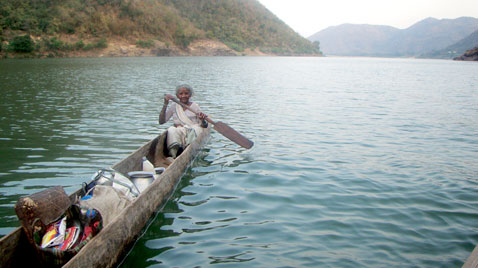/regions/andhra-pradesh-1
Andhra Pradesh
District-wise data on groundwater resources and its utilization in Andhra Pradesh for the year 2004-05 - A compilation by the Andhra Pradesh State Groundwater Department and the Central Groundwater Board
Posted on 31 Dec, 2012 12:00 AMThe data is categorised into watershed wise (basin-wise) annual availability of groundwater, current draft (utilisation), allocation for domestic and industrial needs, availability for future use (or the balance) and categorisation based on stage of development and rigorous statistical treatment of water levels.
The APWELL Project: Andhra Pradesh's experience with participatory hydrological monitoring
Posted on 18 Dec, 2012 02:04 PMPreventing groundwater abuse depends on the users' knowledge of what constitutes this over-exploitation and abuse, and why it is undesirable. The success of APWELL, therefore, depends on participatory hydrological monitoring in which the users were trained in basic hydrology and charged with monitoring the hydrological balance of the watershed.
Godavari river water sharing accord - A paper by N. Sasidhar
Posted on 13 Jun, 2011 03:37 PMThe water availability in these projects has diminished to 33% dependability from the designed dependability of 75% in last nine years. Due to meager inflows, the river water quality is becoming unsafe for human and cattle consumption. It also suggests the remedial action to overcome the problem in future.
Fluorosis in an urban slum area of Nalgonda - Andhra Pradesh - An epidemiological study - Indian Journal of Public Health
Posted on 07 Jun, 2011 10:09 AM.
Polavaram fraud - The Polavaram dam on the Godavari could displace 400,000 people and submerge nearly 4,000 hectares of forest land - Article from Down To Earth
Posted on 06 May, 2011 08:33 PMMost of the people threatened to be displaced cannot be relocated until their rights over forestland are recognized under the Forest Rights Act. How did the Andhra Pradesh government meet this immense challenge? It quietly told the Union environment and forests ministry that all claims have been settled.
The ministry gave forest clearance to the project last year. Now over 50 villages have written to the ministry, saying their forest rights have not been settled. Richard Mahapatra visited the villages and found the state had indeed lied.
Following similar complaints, the ministry had scrapped Vedanta’s proposal to mine Niyamgiri hills and withheld forest clearance to the POSCO steel plant in Odisha. Will it apply the same yardstick to Polavaram?
 Residents of Teladibbalu did not know they had forest rights. The village is in the dam’s submergence zone and accessible only by boat. (Photo: G Srinivas).
Residents of Teladibbalu did not know they had forest rights. The village is in the dam’s submergence zone and accessible only by boat. (Photo: G Srinivas).
Resistance against the Polavaram dam - An EPW article
Posted on 19 Apr, 2011 11:02 PM
This EPW paper studies the various forms of resistance against the construction of Polavaram dam, and notes that the main feature of the struggles has been the involvement of people’s organisations due to the failure of traditional as well as statutory bodies, representatives and regional leadership of mainstream political parties.
Barrages as a better alternative to Polavaram dam project
Posted on 20 Mar, 2010 06:34 PMBARRAGES AS A BETTER ALTERNATIVE TO POLAVARAM DAM POJECT
(Replies to Discussion Report of Advisory Committee on alternate proposals made for
Polavaram project by Sri.T.Hanumantha Rao, former Engineer-in-Chief, AP State)
Barrages would prevent Polavaram dam from being an economic and environmental disaster : Analysis reveal
Posted on 12 Jan, 2010 02:20 PMProf.T.Shivaji Rao,
Director, Centre for Environmental Studies,
Gitam University, Visakhapatnam.
Historical Developments: Initially the Polavaram project was proposed as a storage reservoir with FRL at +150ft with a water storage of about 150TMC in 1941. Subsequently many changes were made and in 1948 it emerged as Rampada Sagar dam with FRL at +208ft. with water storage of 836 TMC including 150 MW of hydro-power generation at an estimated cost of 129 crores (at 1948 rates) This scheme was abandoned because it was too costly and was bristled with foundation and construction problems. Subsequently several expert committees were appointed by the Government of India to study the problems of Godavari water utilisation. These committees under the Chairmanship of Dr.A.N. Khosla (1953), Mr.Gulhati (1963) and Mr.A.C.Mitra (1965) suggested to the state Government to build a barrage at Polavaram for improving the irrigation facilities and also to divert Godavari flood water into Krishna river. https://www.thehindu.com/2009/05/02/stories/2009050260540600.htm